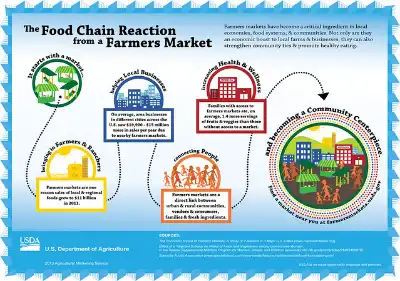Buying Local in a Buzzing Economy
Author: Hannah Henry
Community Involvement
Published:
Tuesday, 02 Jul 2019
Sharing

Image caption: The food chain reaction to a Farmer's Market
How many times have you heard “Buy Local” or “Support Local Businesses”? Probably hundreds of times. So why this “local” push? What does it do for you or your community? With summer here, the concept of buying locally will only increase, specifically about your local farmers' markets. While providing you with delicious produce, farmers markets potentially have a more significant impact on the community than it does just in your fridge.
First off, let’s explore some fun facts:
- Did you know that foods in the U.S. travel an average of 1,500 miles just to get onto your plate? Besides providing community perks, farmers markets cut down on the pollution due to these extensive trips.
- The growers that you meet at farmers markets can also answer all of your questions about what products they have, where they came from, and how they were grown or raised.
- People who shop at farmers markets have 15-20 social interactions compared to 1-2 per visit if they went to the grocery store! Talk about getting connected in your community!
- The USDA’s Agriculture Marketing Service began tracking the farmers market activity in 1994. Since then, the markets in the United States have grown to 8,720, which is a little over 7% from 2013 alone.
- The total annual sales from U.S. farmers markets are valued at about $1 billion!
What are Farmers Markets
To start let’s define what farmers markets really are. In essence, these local markets include farmers who live in nearby towns who bring their fresh produce and more to an open space, most likely an open parking lot, for community members to purchase. Believe it or not, the USDA has actual state rules and operating guidelines that farmers have to follow in order to be eligible to sell their vegetables and fruits, which means their locally grown items have been reviewed by similar, if not the same, standards as your grocery store products! In order to participate, the farmer or vendor agrees to pay a fee or percentage of their sales for their booth space.
Inside the Community Economy
Now, let’s jump into the good stuff- the economic impact of farmers markets in your very own communities! To start us off, did you know 89% of farmers surveyed reported sourcing their supplies locally, meaning that what they receive from their communities they are essentially putting back in! This is nearly 2 times the amount of money that is put in compared to wholesale farms, which reported only purchasing 45% of their inputs from their neighbors. To break it down even further, studies conducted by Civic Economics discovered that for every $1.00 we spend at a large grocery store chain, only 15 cents will stay in your local community.
Creating Jobs… Locally
Farmers markets in South Carolina reportedly created between 257-to-361 full-time jobs and generated up to $13 million, by one estimate. Another study from the Sacramento Region in California discovered a job effect of 31.8, which meant for every $1 million of “output” or sales they produce, a total of 31.8 jobs are being created within their community, including on-farm labor and other farm-related positions.
Farmers who are in higher demand by their community members have an opportunity for growth or expansion. By doing so, more “hands-on-deck” during the growing and selling time will be necessary. Through this type of scenario, local community members may find additional work or primary work readily available to them by these farmers.
Ease of Access for Communities
The Farmers Market coalition reported in 2016 that $20.2million in SNAP benefits (aka food stamps) were spent at local farmers markets. Additionally, over half of the farmers market shoppers (60%) reported that their local market had better prices than they experienced in their grocery stores!
Want to start shopping locally this summer? Click here to find a farmers market nearest you!
Learning the impact of local businesses provides an educational opportunity for youth in your community. Amongst all Junior Achievement’s programs, JA Our Community puts a high focus on helping elementary-school students understand how their community operates, what they can do to contribute, and how their local economy works.
Select a button below to see how you or your organization can get involved with Junior Achievement of Greater St. Louis, Inc..
Donate Volunteer Request A Program